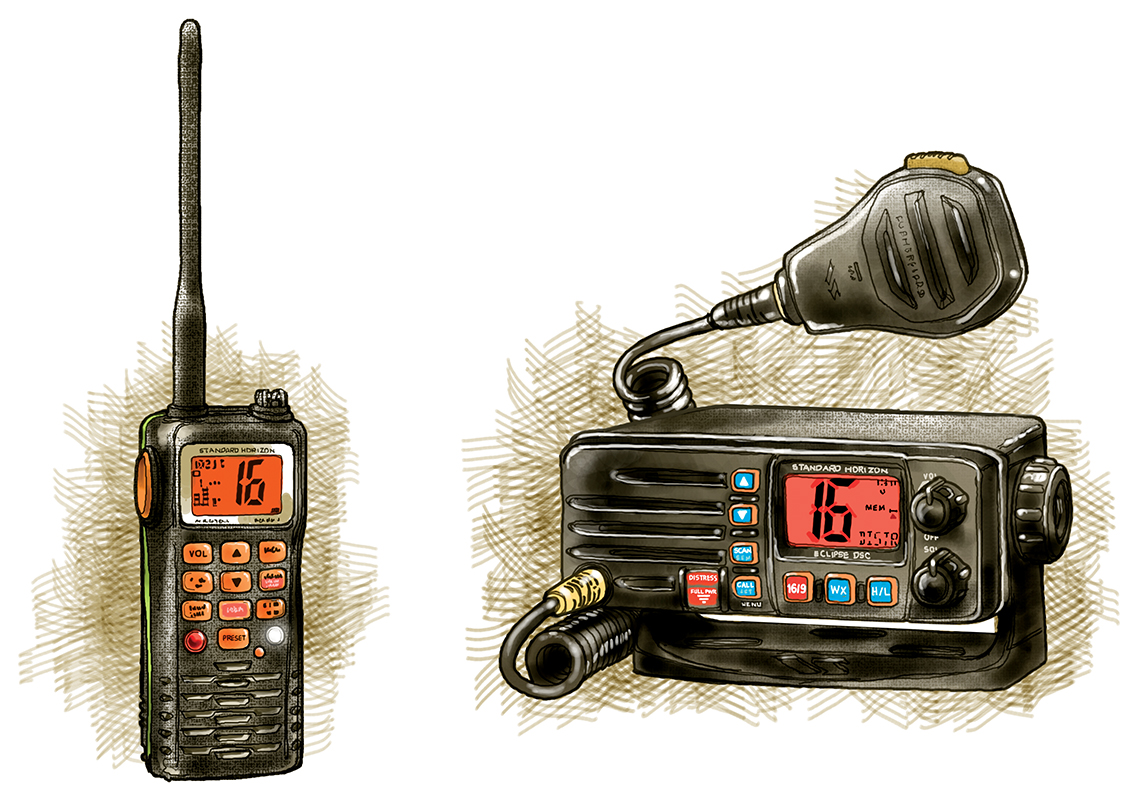
A Beginners Guide to VHF Radios
The VHF marine radio on a small recreational boat provides communications with other boats, situational awareness for safe navigation in the vicinity of larger vessels, and in an emergency it can save your life. There is no substitute! Communications at sea have been important through the ages. Until the advent of modem electronics, boaters were limited to short-distance communications using code flags, flashing lights using Morse code, and whistle signals. In the early days of electronic communications, only large ships with radio operators could afford to communicate electronically, but now with reliable low-cost fixed and handheld VHF marine radios we can all have good communication.
While the cell phone can be an added convenience aboard (and smartphones make weather reports even more accessible), it should not be substituted for a VHF radio. The VHF’s capabilities and reliability far exceed that of the cell phone. It has a bandwidth dedicated to marine use. The Coast Guard continuously monitors Channel 16 and is required to respond if you make an emergency call. Also, while most VHF units are waterproof, almost all cell phones are rendered useless if submerged. The VHF radio also enables boats to respond to one another in both emergency and non-emergency situations. So, learn to use a VHF radio—it really could save your life one day.
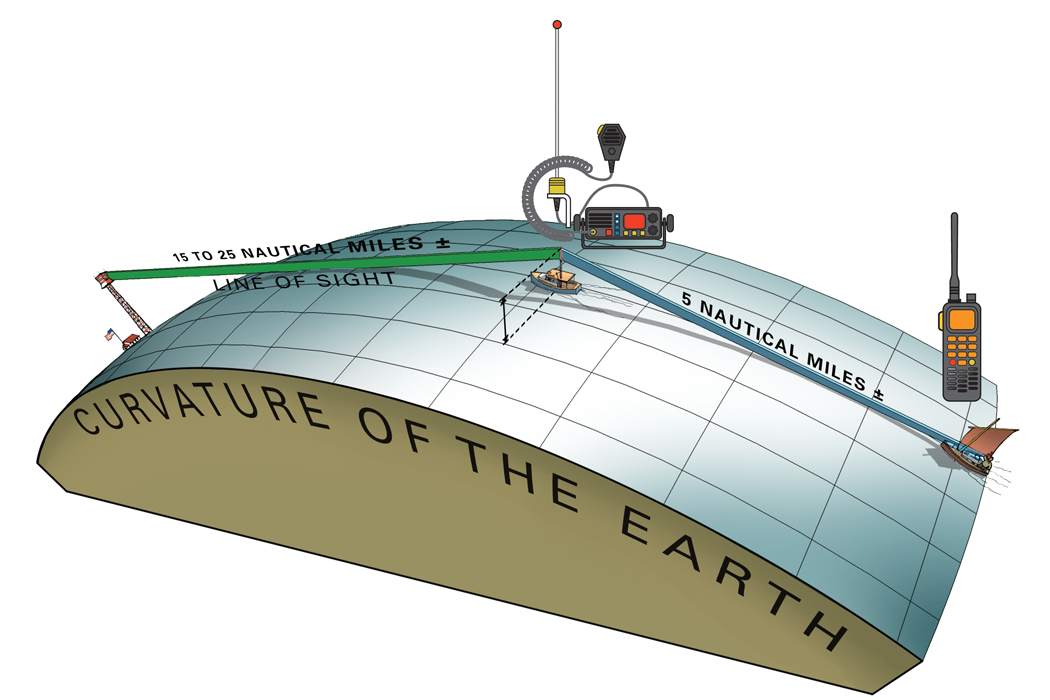
Your line of sight combines with the power of your VHF for total transmittal range. A fixed-mount radio with antenna will transmit farther than a handheld VHF. Know your unit’s limit before you head out on the water.
VHF Signal Basics
The VHF marine radio utilizes very high frequency (VHF) radio waves in the 156 to 158-megahertz range to transmit and receive voice signals. It also picks up weather information on receive-only channels in the 162 to 163-megahertz range. At these high frequencies, the radio waves travel only in a straight line (line of sight), which means that the signal will not follow the curvature of the Earth and can be obstructed by obstacles such as mountains and buildings. As a result, the strength of the transmitter combined with the height of both the transmitting and receiving antennas determines the distance that a VHF marine radio can communicate. If two small boats are trying to communicate with handheld radios set to full power but whose antennas are only 6 feet above
The water, the line of sight limits the distance of transmission to approximately 5 miles due to the curvature of the Earth getting in the way (see illustration). While the boater with a handheld VHF can receive signals from the National Oceanic and Atmospheric Administration (NOAA) weather channels and Coast Guard shore stations (both of which have powerful, high antennas) over great distances, they may not be able to respond to the Coast Guard because their own transmit distance is limited. A more powerful fixed radio with a higher antenna, however, can transmit and receive over longer distances, usually in excess of 15 nautical miles—about three times that of a handheld unit. We will discuss fixed-mount and handheld radios in greater detail later on.
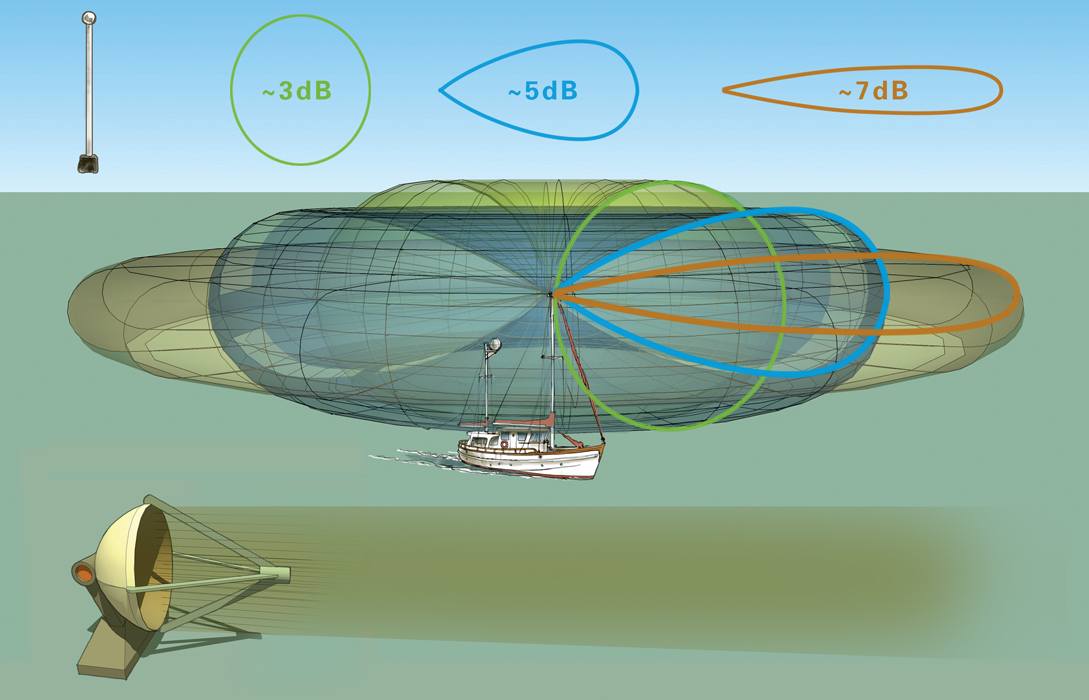
VHF stands for Very High Frequency. The higher the frequency, the more stretched out the signal (and its range) will be. Long-range marine antennas mounted on a sailboat or an 8-foot antenna on a powerboat are common, and both greatly increase the range of sight. Combine that with a fixed-mount radio that can transmit at high power (25 watts), and you will be able to communicate with other boats and land-based stations over 15 miles away.
The VHF marine radio has over 100 channels, but only a few are available for use by recreational boats. The most important one is Channel 16, the distress, safety. and calling channel
The working channels available to non-commercial boaters-Channels 68, 69, 71, 72, and 78A-are those you can use to communicate with other boats. Each channel has a specific use. and it is very It is important to use the channels only for their specified purpose. The Federal Communications Commission (FCC) monitors radio traffic and can fine a boater for breaking the rules. The channels available for recreational boaters are listed on the facing page. Additionally, there are 10 weather channels that broadcast NOAA weather information; these are receive-only channels.
Channels
Channel 06, inter-ship safety. Channel 06 is used to contact an approaching vessel to arrange safe passage or other safe navigation. Recreational boaters usually avoid using this channel but should listen to gain situational awareness of commercial traffic in their area.
Channel 09, boater calling channel, commercial and non-commercial (recreational). Channel 09 is used to contact an approaching vessel to arrange safe passage or other safe navigation. Also used to contact bridge operators on the Intracoastal Waterway. This channel is very short-range, approximately 1 nautical mile, because it is limited to 1 watt of power for close-in communication. Commercial vessels routinely use this channel to share local knowledge concerning safe navigation. A recreational boater should listen when passing through waters shared by commercial vessels to gain situational awareness of what the large vessels are doing. In most cases, you should not contact the large vessel—just stay out of its way.
Channel 16, international Distress, Safety and Calling (Hail and Distress). Monitor (listen to) this channel to receive safety information and to hear other boats, particularly those in distress. Only use this channel to make a brief call to make contact with another vessel, and then immediately switch to a working channel. It is important that this channel be kept clear for others to use, especially for emergency transmissions.
Channel 22A, Coast Guard Liaison and maritime safety broadcasts. The Coast Guard uses this channel to broadcast maritime safety information. The Coast Guard will announce on Channel 16 when a broadcast is to be made so that you can switch to 22A to hear it. The Coast Guard also uses this channel as a transfer point to continue a communication that was initiated on Channel 16.
Channels 68, 69, 71, 72, 78A, Non-commercial (recreational). These are “working channels.” After calling another boat on Channel 16 or 9, immediately switch to one of these channels to continue your conversation.
Channels WX01 through WX10, Weather. (Receive only). Tune in to these channels to hear continuous NOAA weather broadcasts, which include all types of weather information including forecasts and radar summaries. Each broadcast is approximately 10 minutes long and then is repeated. The weather information is updated as needed.
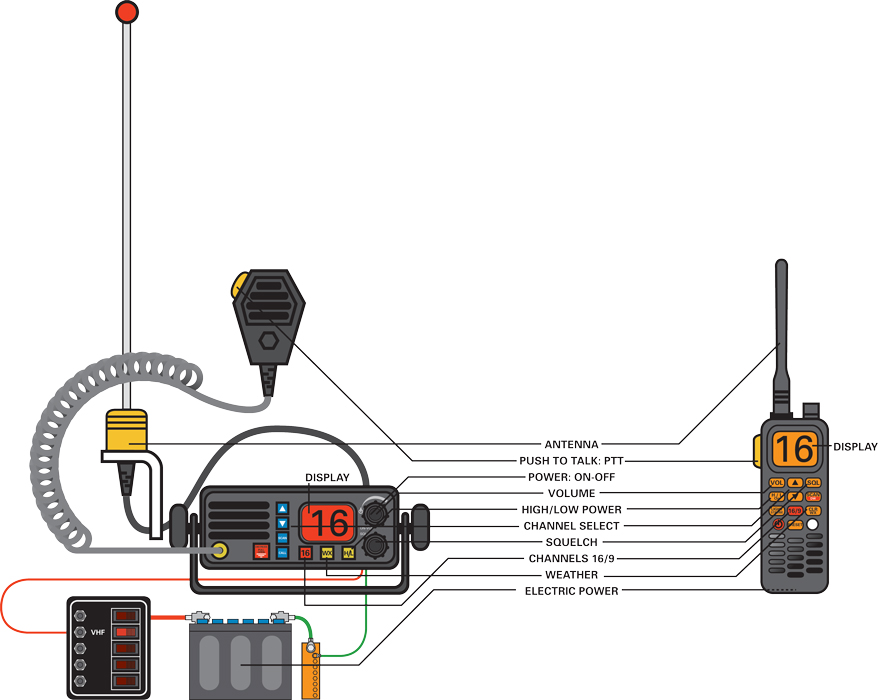
Primary control functions of marine radios are generally the same, but each manufacturer configures them a little differently. Be sure to study your owner’s manual so that you understand how to use your particular radio. The controls shown here are common to all VHF radios.
Using VHF Radios
VHF Radio Types
There are two basic styles of VHF marine radios:
1. The fixed-mount radio that is permanently installed on the boat along with a separate antenna
2. The handheld radio with an integral antenna.
Fixed-Mount VHF Radio
The fixed radio is more powerful and, with the right antenna, will transmit and receive over much longer distances than handheld models. The fixed radio must be mounted in the boat and connected to the 12-volt battery electrical system with a dedicated inline fuse. It must also be connected to an antenna that is mounted as high as possible to get the greatest range. On sailboats, it is common to use a 3-foot-long stainless-steel antenna mounted at the masthead, and on powerboats, it is usual to install a longer (8-foot) fiberglass model. The fixed radio can transmit at high power (25 watts) or low power (as low as 1 watt). With high power and a high antenna, this radio should be able to transmit in excess of 15 miles. As mentioned earlier, you should always use the lowest power that will allow you to communicate so that you interfere with the fewest number of other people who are using the same channel.
Handheld VHF Radio
The handheld radio is less powerful and its maximum transmit distance is approximately 5 nautical miles, but because it has its own battery for power and a built-in antenna, it is easy to carry around and is especially useful on small boats with no built-in electrical system. I keep a handheld radio in my gear bag that I take with me whenever I go boating. It serves as my primary radio on small boats and as a backup on larger boats. Modern handhelds are usually submersible and many even float. A handheld can be a lifesaver in an emergency; for example, if you swamp and need to call for help, like the fellow depicted on the cover. When operating a small boat, keep the radio on your person so it will be with you in an emergency.
VHF Protocol
The FCC monitors VHF radio traffic to check that users are acting in compliance with its rules; they are specific about which channels are to be used for what purpose and the language that’s spoken. It is important to use the proper words in your transmission so that those listening will immediately understand what you are saying.
EMERGENCY ON CHANNEL 16:
If you have a serious emergency, such as sinking or a threat to life, call for help on Channel 16.
Push the push-to-talk (PTT) button and say, “Mayday, Mayday, Mayday, this is _____ (your vessel’s name). Mayday, this is _____ (your vessel’s name).”
Report your position with latitude and longitude or distance and bearing from a known location.
Explain the nature of your distress (sinking, collision, fire, heart attack, injury, etc.).
State the kind of assistance you need (pumps, medical assistance, etc.).
State the number of persons on board and the condition of anyone who is injured.
Give an estimate of present seaworthiness and the condition of your boat.
Give your boat’s description (length, type, color, and other distinguishing features).
End the message by saying, “Over.”
Wait for an answer and, if no answer, repeat your call.
A sample call would be:
‘Mayday, Mayday, Mayday, this is DOVE. Mayday, this is DOVE. I am located 1 mile southwest of Cape Rosier in Penobscot Bay, I hit a log and am taking on water rapidly. I need rescue and/or pumps. There is one adult and one child aboard both wearing PFOs. We are in danger of swamping. DOVE is a 16’ open motorboat with off-white hull and buff trim. Over.”
To call another vessel on Channel 16 or 9: Turn on the channel and listen for at least 30 seconds to be sure no one else is using it, then push the push-to-talk button and say, “(The name of the vessel being called)” and then “this is (Your vessel’s name or call sign).” When the other vessel answers, immediately say:
“Go to __ (the number of the channel you wish to talk on)” and then say, “Over” so that others waiting to use the channel know you are finished. Go to the new channel, and when it is not busy call the vessel by pushing the push to-talk button and say, ” _____ (The name of the vessel being called)” and then “This Is _____ (your vessel’s name or call sign).”
VHF Radio Licenses
The FCC used to require that all VHF marine radios have a station license and that each operator be licensed. This is no longer required for recreational vessels in the United States, but commercial vessels and recreational vessels being used in Canada still require a license. For other countries or for international passage, check with each country’s maritime regulatory and lifesaving organizations (the equivalent of the U.S. Coast Guard).
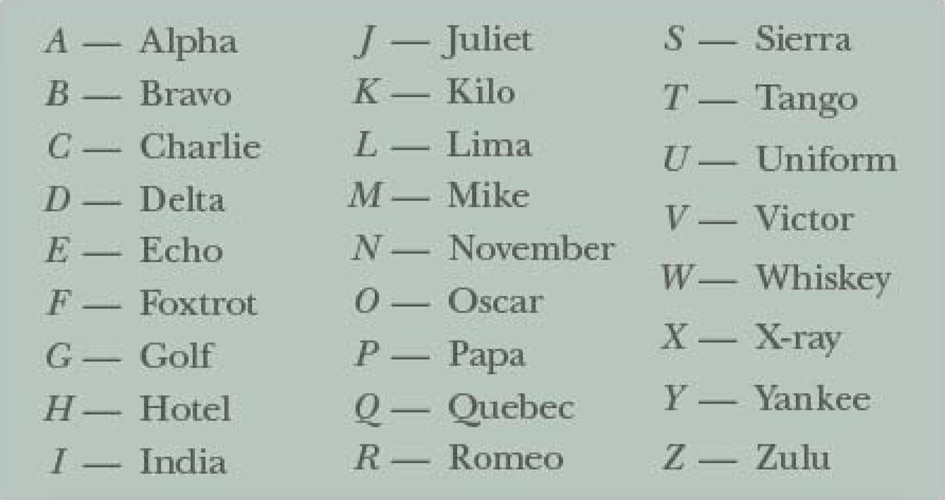
The Phonetic Alphabet
The Phonetic Alphabet uses words that are at once easy to understand in a variety of accents and difficult to confuse with another word. In the sample call on page 1, the caller might be required to spell out one or more of the words to ensure clarity at the receiving end of the transmission. He might say, “Mayday, Mayday, Mayday, this is DOVE. Mayday, this is DOVE: Delta, Oscar, Victor, Echo…”
There are plenty of fun games you can play to learn the Phonetic Alphabet; one good one is to run practice drills using your name, the name of your boat, and those of your favorite cruising locales. However you learn it, it’s important to commit it to memory so that you will be ready to use it in an emergency.
David Wyman is a Professionally trained mariner who works as an independent naval architect and marine surveyor.

